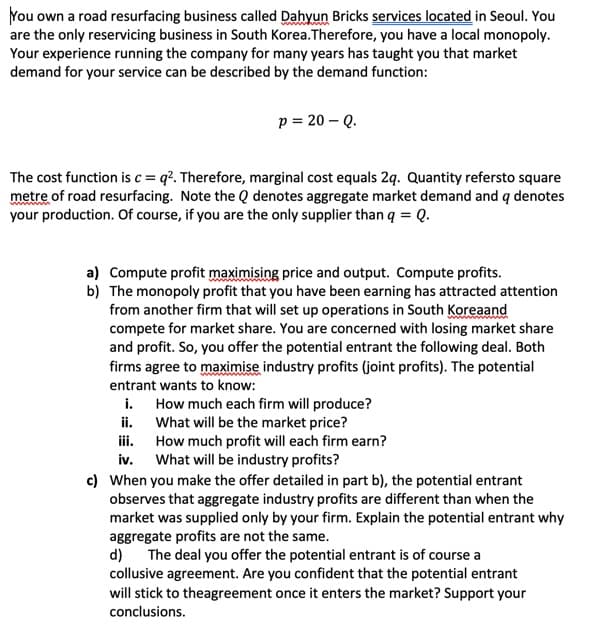The cost function is c =q². Therefore, marginal cost equals 2q. Quantity refersto square metre of road resurfacing. Note the Q denotes aggregate market demand and q denotes your production. Of course, if you are the only supplier than q = Q. a) Compute profit maximising price and output. Compute profits. b) The monopoly profit that you have been earning has attracted attention from another firm that will set up operations in South Koreaand compete for market share. You are concerned with losing market share and profit. So, you offer the potential entrant the following deal. Both firms agree to maximise industry profits (joint profits). The potential entrant wants to know: i. How much each firm will produce? What will be the market price? ii. iii. How much profit will each firm earn? iv. What will be industry profits? c) When you make the offer detailed in part b), the potential entrant observes that aggregate industry profits are different than when the market was supplied only by your firm. Explain the potential entrant why aggregate profits are not the same.
The cost function is c =q². Therefore, marginal cost equals 2q. Quantity refersto square metre of road resurfacing. Note the Q denotes aggregate market demand and q denotes your production. Of course, if you are the only supplier than q = Q. a) Compute profit maximising price and output. Compute profits. b) The monopoly profit that you have been earning has attracted attention from another firm that will set up operations in South Koreaand compete for market share. You are concerned with losing market share and profit. So, you offer the potential entrant the following deal. Both firms agree to maximise industry profits (joint profits). The potential entrant wants to know: i. How much each firm will produce? What will be the market price? ii. iii. How much profit will each firm earn? iv. What will be industry profits? c) When you make the offer detailed in part b), the potential entrant observes that aggregate industry profits are different than when the market was supplied only by your firm. Explain the potential entrant why aggregate profits are not the same.
Managerial Economics: Applications, Strategies and Tactics (MindTap Course List)
14th Edition
ISBN:9781305506381
Author:James R. McGuigan, R. Charles Moyer, Frederick H.deB. Harris
Publisher:James R. McGuigan, R. Charles Moyer, Frederick H.deB. Harris
Chapter16: Government Regulation
Section: Chapter Questions
Problem 10E
Related questions
Question

Transcribed Image Text:You own a road resurfacing business called Dahyun Bricks services located in Seoul. You
are the only reservicing business in South Korea. Therefore, you have a local monopoly.
Your experience running the company for many years has taught you that market
demand for your service can be described by the demand function:
p = 20 - Q.
The cost function is c =q². Therefore, marginal cost equals 2q. Quantity refersto square
metre of road resurfacing. Note the Q denotes aggregate market demand and q denotes
your production. Of course, if you are the only supplier than q = Q.
a) Compute profit maximising price and output. Compute profits.
b) The monopoly profit that you have been earning has attracted attention
from another firm that will set up operations in South Koreaand
compete for market share. You are concerned with losing market share
and profit. So, you offer the potential entrant the following deal. Both
firms agree to maximise industry profits (joint profits). The potential
entrant wants to know:
i.
How much each firm will produce?
What will be the market price?
ii.
iii.
How much profit will each firm earn?
iv. What will be industry profits?
c) When you make the offer detailed in part b), the potential entrant
observes that aggregate industry profits are different than when the
market was supplied only by your firm. Explain the potential entrant why
aggregate profits are not the same.
d) The deal you offer the potential entrant is of course a
collusive agreement. Are you confident that the potential entrant
will stick to theagreement once it enters the market? Support your
conclusions.
Expert Solution
This question has been solved!
Explore an expertly crafted, step-by-step solution for a thorough understanding of key concepts.
Step by step
Solved in 3 steps

Knowledge Booster
Learn more about
Need a deep-dive on the concept behind this application? Look no further. Learn more about this topic, economics and related others by exploring similar questions and additional content below.Recommended textbooks for you

Managerial Economics: Applications, Strategies an…
Economics
ISBN:
9781305506381
Author:
James R. McGuigan, R. Charles Moyer, Frederick H.deB. Harris
Publisher:
Cengage Learning



Managerial Economics: Applications, Strategies an…
Economics
ISBN:
9781305506381
Author:
James R. McGuigan, R. Charles Moyer, Frederick H.deB. Harris
Publisher:
Cengage Learning




Economics (MindTap Course List)
Economics
ISBN:
9781337617383
Author:
Roger A. Arnold
Publisher:
Cengage Learning
